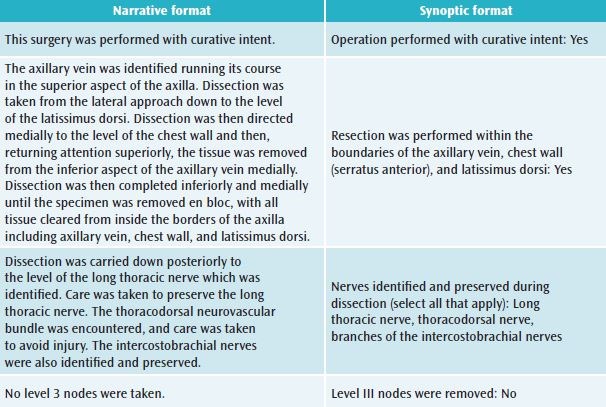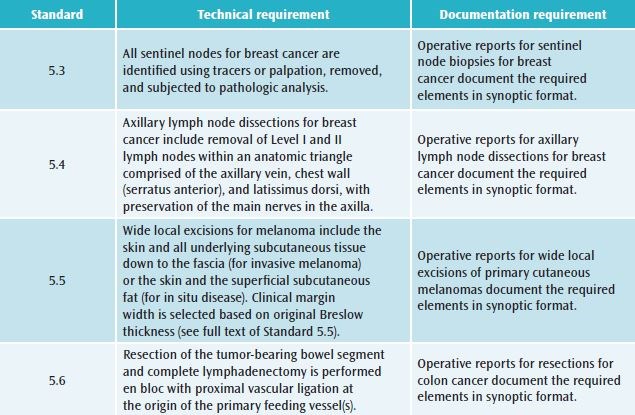CoC site visits taking place in 2024 will begin to review operative reports from 2023 to assess for compliance with each standard. For that year of reviews, the cancer program must meet the threshold compliance level of 70 percent for each standard by having at least five fully compliant operative reports of seven assessed reports. The threshold of compliance will increase to 80 percent starting with site visits in 2025, which will review operative reports from 2023 through 2024.
Surgeon awareness of the CoC Operative Standards
In early 2021, the Cancer Surgery Standards Program distributed an anonymous survey to surgeons at CoC-accredited cancer programs to gauge their general awareness of the CoC Operative Standards. The survey was set up so that surgeons only answered questions about the operations they performed regularly. The survey included specific questions on the technical aspects of melanoma, colorectal, breast, and lung cancer surgery, as well as separate questions on the requirements of the CoC accreditation standards.
Of the 377 respondents, the average scores for surgical technique questions were consistently more than 80 percent across all four disease site specialties, but average scores on questions specific to the accreditation standards were significantly lower (as low as 53 percent in colorectal and 54 percent in melanoma). These results indicate a need to educate surgeons and other stakeholders on the CoC Operative Standards. Future educational efforts will focus on improving knowledge of the standards.
Looking ahead
Over the next decade, operative reports will continue to evolve toward synoptic reporting. We are only in the early stage of implementation, which involves using early versions of synoptic operative reports to demonstrate compliance with the CoC accreditation standards. As we learn from this process, we aim to advance synoptic operative reports toward standardized, complete, and electronic health record-integrated reports that can be universally implemented across all cancer programs. This will allow for more interoperability, or data sharing across groups and automated data abstraction, leading to improved quality of care.
To that end, beginning in 2026, the CoC will work toward expanding requirements for synoptic operative reporting, with the future goal of transitioning to full synoptic operative reports. Additional cancer features in synoptic format will likely be required and new operative standards will be implemented for disease sites not already represented in the CoC standards for accreditation. Details on future changes to the CoC Operative Standards or synoptic operative reporting requirements will be shared with CoC-accredited cancer programs once available.
For more information, two articles on the CoC Operative Standards and synoptic reporting will be published in the coming months in the Annals of Surgical Oncology. We look forward to leading the surgical community on this journey toward synoptic operative reporting for cancer surgery and higher-quality cancer care.
References
- Stogryn S, Hardy KM, Abou-Setta AM, Clouston KM, Metcalfe J, Vergis AS. Advancement in the quality of operative documentation: A systematic review and meta-analysis of synoptic versus narrative operative reporting. Am J Surg. 2019;218(3):624-630.
- Eryigit Ö, van de Graaf, Floyd W, Lange JF. A systematic review on the synoptic operative report versus the narrative operative report in surgery. World J Surg. 2019;43(9):2175-2185.
- College of American Pathologists. Cancer protocols. Available at: https://www.cap.org/protocols-and-guidelines/cancer-reporting-tools/cancer-protocols. Accessed October 15, 2021.
- Sluijter CE, van Lonkhuijzen LRCW, van Slooten H, Nagtegaal ID, Overbeek LIH. The effects of implementing synoptic pathology reporting in cancer diagnosis: A systematic review. Virchows Archiv. 2016;468(6):639-649.
- American College of Surgeons. Optimal Resources for Cancer Care (2020 standards). Available at: https://www.facs.org/-/media/files/quality-programs/cancer/coc/optimal_resources_for_cancer_care_2020_standards.ashx. Accessed October 15, 2021.
- American College of Surgeons. Optimal Resources for Rectal Cancer Care (2020 standards). Available at: https://www.facs.org/-/media/files/quality-programs/cancer/naprc/optimal_resources_for_rectal_cancer_care_2020_standards.ashx. Accessed October 15, 2021.
- Nelson H, American College of Surgeons, Alliance for Clinical Trials in Oncology. Operative Standards for Cancer Surgery, Volume 1. Philadelphia, PA: Wolters Kluwer Health; 2015.
- Katz MH, American College of Surgeons, ACS Clinical Research Program. Operative Standards for Cancer Surgery, Volume 2. Philadelphia, PA: Wolters Kluwer Health; 2018.


